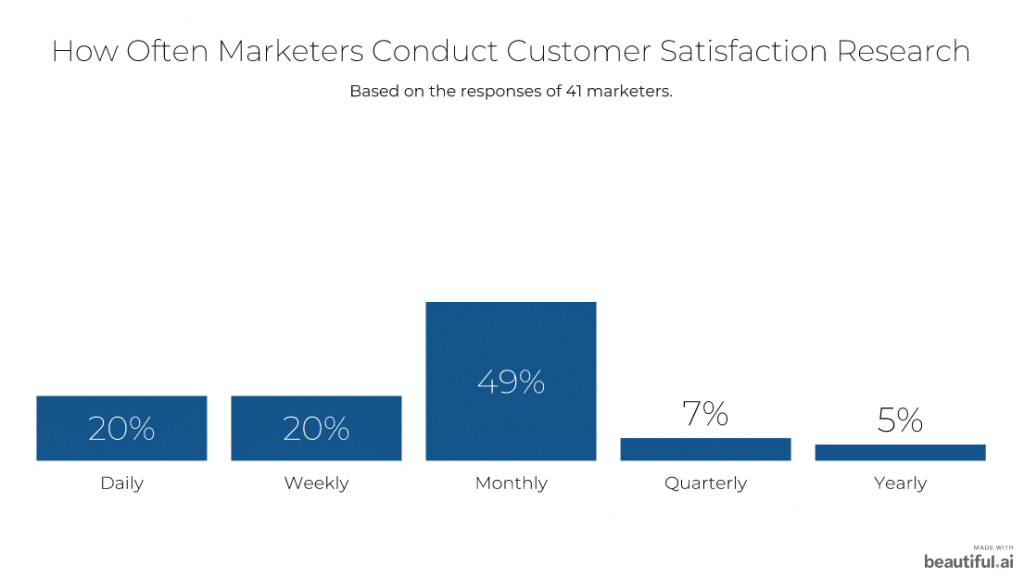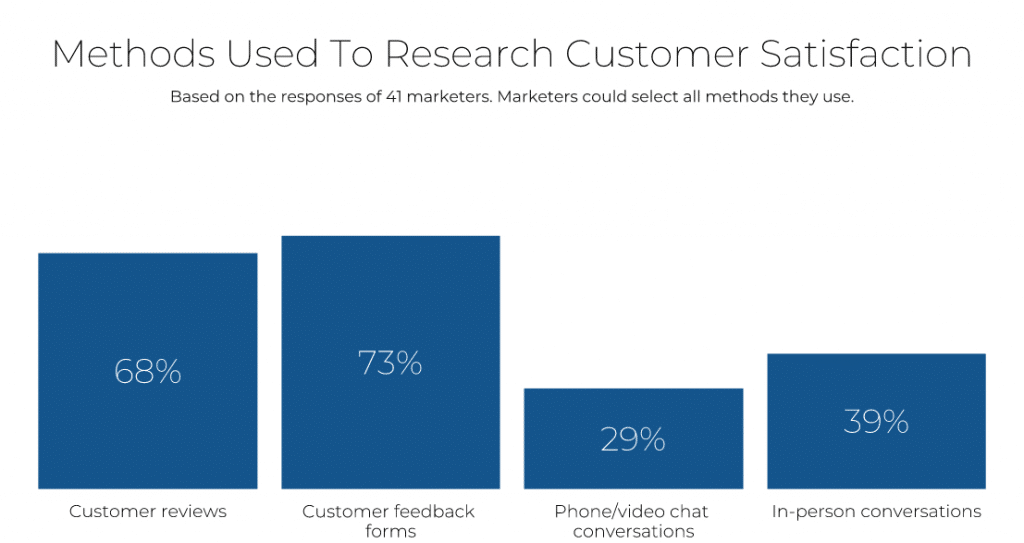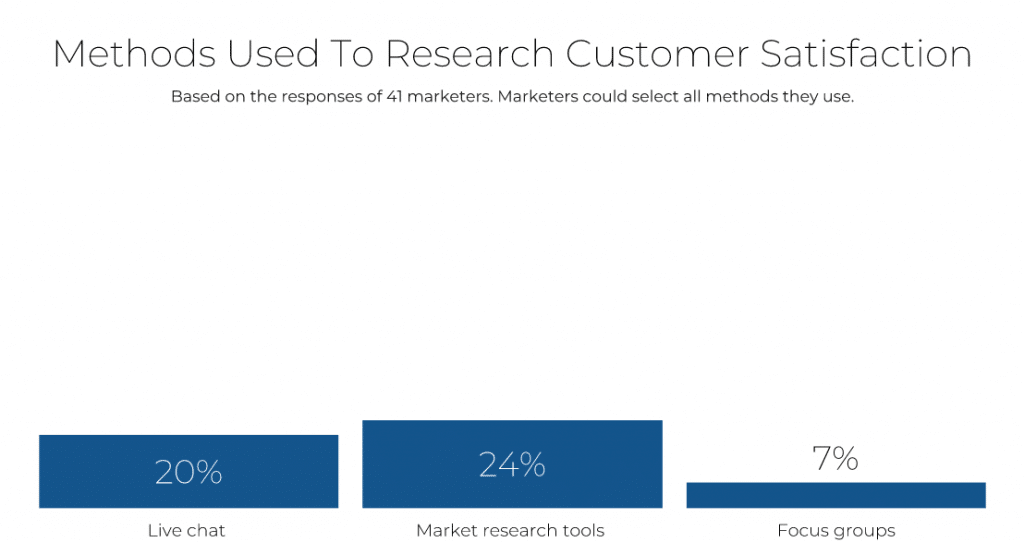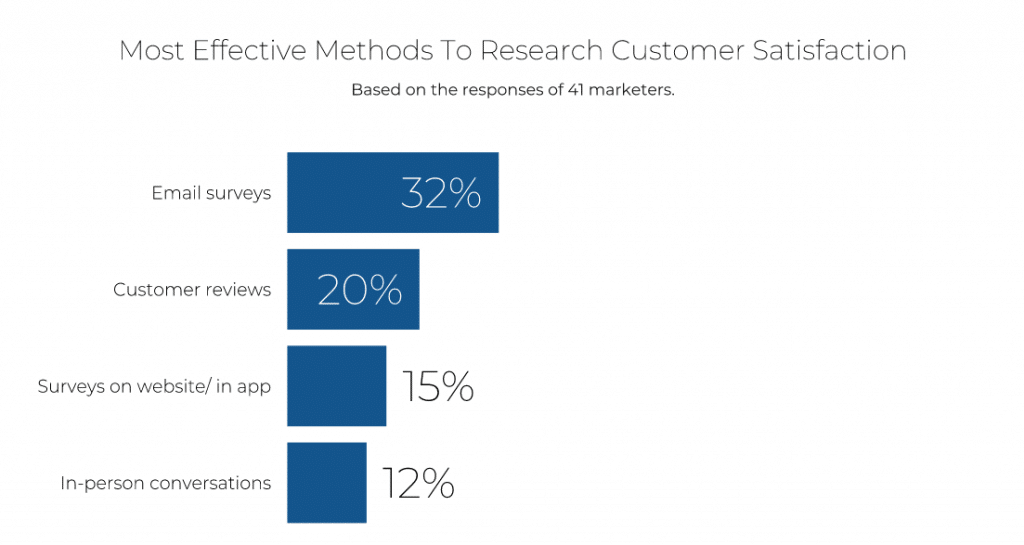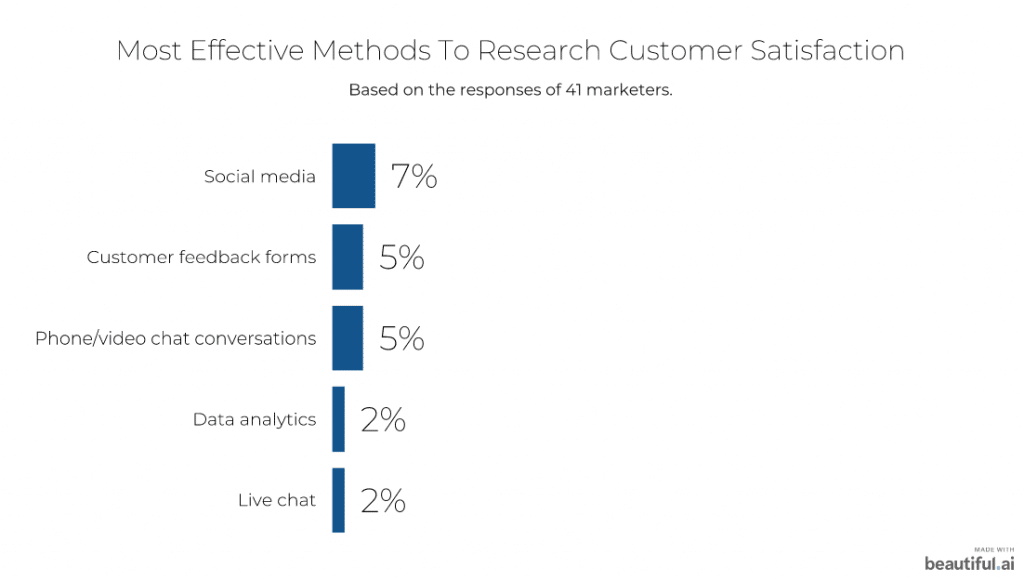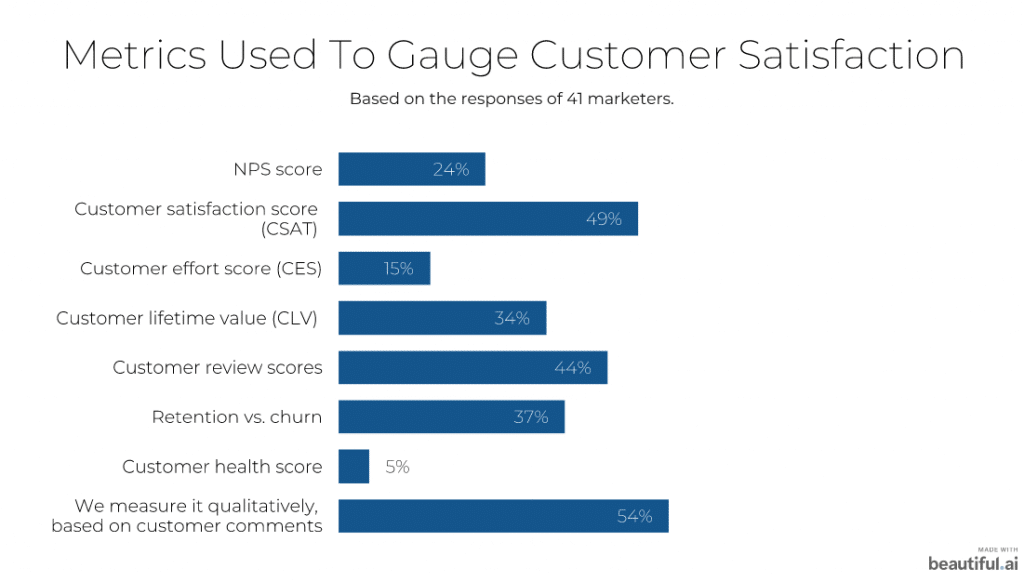Marketers overwhelmingly agree: It’s vital to research customer satisfaction.
After all, if you don’t know how satisfied customers are with your products or services, what you’re doing well, and what you could improve, your brand will struggle to acquire and retain customers. And only the most satisfied customers will refer their friends to your business!
When we asked 41 marketers to rate the importance of researching customer satisfaction, they gave it a 4.88 out of 5 (with 5 being “of greatest importance.”)
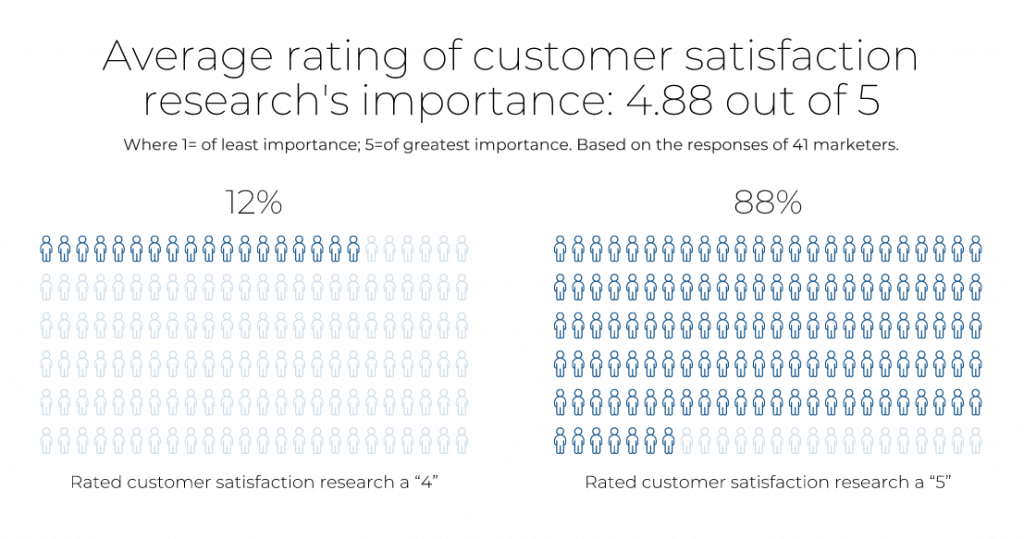
But how do these marketers research customer satisfaction? What methods and research questions do they find most effective? Let’s dive into their expert insights.
Most companies research customer satisfaction at least once a month
First, how often do marketers research customer satisfaction?
While it varies, most marketers conduct research often. There was no majority answer, but 49% conduct customer satisfaction research monthly, 20% conduct it weekly, and another 20% conduct it daily.
Even with this variation, it’s still clear conducting frequent customer satisfaction research is best to gain an accurate picture of your customer’s changing opinions.
Most popular customer satisfaction research method: Email surveys
How exactly do marketers research customer satisfaction?
Email surveys are the most popular method (85% of marketers use them), followed by customer feedback forms (73%) and customer reviews (68%).
Email surveys can be easily personalized and sent right after a purchase, and customer feedback forms are also easy to deploy, making them simple and popular methods.
As for reviews, they’re often given by customers unprompted, so they provide a genuine picture of how customers feel. They’re also very easy to request and unearth.
7 most effective methods to research customer satisfaction
We then asked marketers to single out the method they find most effective for researching customer satisfaction, based on the above list.
Email surveys were the most effective method for 32% of marketers (making them the most popular and effective).
Customer reviews were selected by 20%, putting it in the second position.
These methods were followed closely by website/in-app surveys (15%) and in-person conversations (12%).
But why do marketers find these methods of researching customer satisfaction most effective? Hopefully, their explanations below will help you choose the methods that will work for you.
Email surveys
“We get the most responses via email surveys. They have provided us with more constructive feedback that’s easy to track and save information compared to other methods.” –Suzanne Pope, Whiterock Locators
“We often don’t give email the kudos it deserves. When a customer signs up for a service or purchases a product, an email a few days later can help a company understand just how well they hit the mark.” –Andrea Loubier, Mailbird
“In my opinion, a quick email survey is always the best way to get customer feedback without making them commit too much of their time. Email surveys are non-intrusive, not time-sensitive, and allow the customer to take their time to respond and produce a quality review.” –Mikkel Andreassen, Dixa
“People are more likely to reply when they are sent a personalized email with some questions about the services they have received.” –Maria Saigatova, Blast Sourcing
In-app surveys
“In-app functionality allows you to deliver targeted surveys to your customers and engage them at the ideal time to receive valuable customer feedback, all while providing a seamless customer experience.” –Cori Pearce, ChurnZero
Customer reviews
“Prompting customers to leave reviews can be beneficial to both parties. Customers can express their likes and dislikes, often in an anonymous way should they like. And this information can help a customer service department go from good to great.” –Sergei Belous, UpFlip
“Customer reviews are the way to receive the most genuine feedback possible. With no incentives for providing feedback, customers only do so if they’re very impressed with your services, or if they can offer criticism you can use to create growth and positive change.” –Alice Ray, Know Your Chickens
In-person conversations
“If it’s feasible, in-person conversations are always great to receive detailed customer satisfaction feedback. In-person conversations are effective because they allow the customer to provide specifics regarding their satisfaction/issues without bias from others.” Doreen Amatelli-Clark, Way to Goal Business Insights
“In-person conversations have always worked well for me because I can see the person’s facial expressions and body language much better. Being there in the same room as your client also gives you credibility because you spent your time and went to their office.” –Ben Walker, Transcription Outsourcing
Phone/video chat conversations
“Phone and video chat conversations allow you to dig into a customer’s preferences and really get to know their pain points. You’ll open up new pathways in conversation and learn a lot more than you expected about your most valuable customers.” –David Cusick, House Method
Social media
“Gaining customer satisfaction reactions from social media can be a bold choice, as it’s out there for the entire world to see. However, this can keep you genuine and authentic, and you can take the comments that are posted and devise innovative strategies from them.” –Carrie McKeegan, Greenback Expat Tax Services
Data analysis
“Analyzing data can provide a clear picture of how satisfied our customers are at any point. Are current customers continuing their service? Are they recommending others or even opting for more solutions that are offered? These things can provide a lot of valuable insight.” –Thomas Bolt, Big Eval
NPS
“We have used Net Promoter to gain a snapshot of our performance through the eyes of our current and past customers. Our goal is not only to determine the NPS, but to understand the cause of the score. This is achieved by asking follow-up questions through phone interviews.” –Alex Membrillo, Cardinal Digital Marketing Agency
“When customers are willing to promote your brand among their networks, this is the best marketing money cannot buy. Statistically, people trust the opinions and recommendations of others in their network above any other source. This is why NPS surveys are key.” –Jen Lawrence, Vye
Customer satisfaction metrics: Qualitative metrics are most popular
Now that we know the methods marketers use to research customer satisfaction, what specific metrics do they track?
Interestingly, the most popular metric, and the only one the majority use, is qualitative rather than quantitative.
Fifty-four percent of experts use customer comments to measure customer satisfaction. Comments give a clear picture of why customers are or are not satisfied with your brand. With this insight, you’ll be able to take direct action to increase customer satisfaction.
As for the most popular quantitative metrics:
- 49% use customer satisfaction score (CSAT) (“On a scale of 1-10, how satisfied were you with [product/service/experience]?)
- 44% use customer review scores
- 37% measure customer retention vs. churn
- 34% track customer lifetime value
Specific tools marketers use for customer satisfaction research include:
- Hotjar (behavioral data analytics)
- Buzzsumo (social media monitoring)
- Survey Monkey (simple form building platform)
- ChurnZero (customer success software with customer health scores)
- ReviewInc (customer review management software)
- Survey Sparrow (omnichannel customer experience/survey building software)
- Informizely (website, email, and in-app survey integration)
- Zonka Feedback (CSAT, CES, and NPS survey software)
- Typeform (form building)
- Qualtrics (survey/customer feedback analytics)
- HubSpot (CRM software)
- Mention (social media monitoring/brand mention tools)
8 best types of customer satisfaction research questions
The top customer satisfaction questions shared by marketers were as diverse as the businesses they work for. But there were several common themes in the questions they found most helpful.
Here are the favorite customer satisfaction survey questions, divided by category, for you to draw inspiration from.
Include a scale for people to rate the product
“I would say the best question to ask is, ‘How would you rate our product/service overall?’ based on a scale, since it provides a baseline to measure customer satisfaction.” –Suzanne Pope, Whiterock Locators
“Ask the consumer to score their happiness with the business, product or service, to generate an average CSAT ranking (customer satisfaction score). Usually, a customer satisfaction scale varies from 1–3, 1–5 or 1–10.” –Eliza Nimmick, Tutor The People
Ask why they chose your product/service
“Ask ‘What makes you choose us?’ Give participants a list of possible answers and ask them to rank nos. 1, 2, and 3. Then also give them the opportunity to comment if they wish. The list will spur their thinking, and you will learn both your strengths and weaknesses as compared to your competitors.” –Karen Condor, USInsuranceAgents.com
“Why did you choose our product or service over our competitors? What stood out, and made you choose our particular company?” –Alice Ray, Know Your Chickens
Learn whether they’d use your product or service again
“My key question would be ‘Would you use us again?’ That answers the all important question of how you are doing at building a loyal and engaged customer base for your business.” Adam Korbl, Ifax App
Carefully ask about negatives and places for improvement
“The one question I think you should ask is: “If you could change anything, what would it be?” There may be a lot of different answers, but that’s a good thing, to get different perspectives. If you see a common thread through the answers, you’ll have an idea of what to improve.” –Daniel Foley
“Is there anything about our services or solutions that would cause you to discontinue using them?” –Thomas Bolt, Big Eval
“I recommend the question ‘If a friend asked you about any negatives or downsides, what would you say?’ It’s tough to get negative feedback, especially in in-person or live interviews. Re-framing the “’What’s the worst thing?” question allows the customer to think differently and give honest feedback without feeling awkward about it.” –David Cusick, House Method
“I think you can never go wrong with an open-ended ‘What could have we done better?’ or ‘How can we improve?’ to allow the customer some room to expand and share their thoughts. Some of the best ideas come from your very own customers and with a bit of luck, they can offer excellent insight into your product that can be implemented in the future.” –Mikkel Andreassen, Dixa
“The best question to ask customers when conducting research on customer satisfaction is ‘What would have made the biggest improvement for your experience?’ Then you can nail down what improvements “”will make the biggest overall impact on our customers for the future.” –Jacob Rosenberg, Tajima Direct
Ask how they would rate your customer service
“Ask customers how they would rate your customer service department. This team is often the voice of your company, and you’ll want to clearly portray your company values and ethics.” –Sergei Belous, UpFlip
“Ask ‘Do you feel your experience, from the first email to the last and everything in between, was worth your money and time?’
Those two things are the most important to people and it should be for any business and by bringing those two things up in conversation allows them to answer you from a business point of view and may trigger them to bring up valuable info.” –Shaun Taylor, Moriti Safaris
“How happy are you with our current service compared to what you were expecting when you signed up?” –Jane Kovalkova, Chanty
“Ask customers to rate the customer service they have received on a scale. For example:
- On a scale of 1-10, please rate the service quality provided by the customer service rep.
- On a scale of 1-10, how effectively the customer support rep handled your problem today?
- On a scale of 1-10, how would you rate the friendliness of your customer representative?” –Rorie Devine, Gro.Team
Learn whether customers would refer your business to others
“I think asking the customer if they would refer your business, product or service to others is an important question to ask. If they truly received a great experience and think others would benefit as well, a referral is an inexpensive and easy way to grow business.” –David Peterson, HealthMarkets
“Would you recommend this business to a friend or family member? If yes, why?” –Golda Criddle, ReviewInc
“When conducting these surveys, the best question to ask is, ‘How likely are you to recommend our product to your friends and family members?’ This question gives a great insight in how the customer feels about your product. If they are willing to recommend it to people they care about, that means they are satisfied with your product and will help spread the word about it.” –James Major, Insurance Panda
“Existing customers provide great insights about your business’s products and services. Asking “l’How likely are you to recommend our brand to a friend?’ can show how happy and satisfied they are.
“Telling their experiences to others can help you grow your brand. It can help you build and improve your brand’s services, which can attract more customers. Your existing customers will be your most valuable asset that can help in promoting your brand’s name.” –Dennis Bell, Byblos Coffee
“On a scale of 0-10, how likely are you to recommend our company? This is the net promoter score question.” –Jen Lawrence, Vye
Learn what problem they seek to solve with your product
“Ask, ‘What problem would you like to solve with our product?’ This question seeks information that usually cannot be gauged by analytics.
It’s great to ask this question even before finalizing the sale. It may be the case that your potential customers are looking for something different than their chosen product is. If you have other products that would much better suit their needs, it’s great to navigate them towards them before it’s too late and they get disappointed with a product that was not designed for what they actually need.” –Eliza Nimmick, Tutor The People
Focus on three key components in your questioning
“We would actually argue that effective customer satisfaction research cannot be narrowed down to one key question.
When measuring customer satisfaction for a product or service, researchers should focus on and measure the key components: xs the product/service’s relative importance to the customer, the customer’s expectations and then their satisfaction of that product/service.” –Doreen Amatelli-Clark, Way to Goal Business Insights
Wrapping up
No matter what methods and questions you choose, be sure to research customer satisfaction relatively often, and use both qualitative and quantitative measures. It’s always helpful if you ask customers how willing they are to refer your business to their friends (the NPS question).
When someone is ready to advocate for your business, this shows that they’re highly satisfied – customers won’t recommend you if they aren’t enthusiastic about what you have to offer.
Plus, referrals are an effective engine that will bring new customers to your business – customers who are more likely to stay loyal and satisfied.
Looking for more tips on researching customer satisfaction? Marketers share their top tips and strategies for customer satisfaction research in this roundup.

